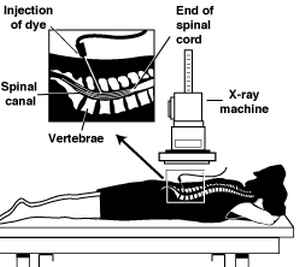

MedFriendly®


Myelography
A myelography is a technique that produces a picture of
the spinal cord and the roots of the spinal nerves by
using radiation (a type of energy), much like how an X-
ray produces a picture. The process involves injecting
a contrast material (a substance that allows damaged
areas to show up better on the picture) into an opening
in the spinal cord known as the subarachnoid space.
The injection is made in the cervical area (neck area)
or the lumbar (lower back area) of the spine. A
myelography is typically done to identify and study
lesions (abnormal areas) of the spine caused by a
disease process (such as a tumor), trauma (spinal cord
injury), or cysts.
A myelography procedure.
FEATURED BOOK: Neuroradiology, The Requisites
A cyst is an abnormal lump, swelling, or sac that contains fluid, a part solid material, or a
gas, and is covered with a membrane. A membrane is a thin layer of flexible tissue that
covers something. A myelography is sometimes used to find the cause of pain that was
not identified through other medical imaging procedures such as computerized axial
tomography (CT) or magnetic resonance imaging (MRI).
Myelography comes from the Greek word "myelos" meaning "marrow," and the word
"graphy" meaning "a drawing." Put the two words together and you get "a drawing of the
marrow," where marrow refers to the spine.
"Where Medical Information is Easy to Understand"™















